The Lusitania Sinking: "Be British Boys"
On May 7, 1915, the Cunard liner Lusitania was torpedoed and sunk by a German U-boat, causing the deaths of 1,195 passengers and crew.
Thomas Snowden was a 30-year-old third-class passenger on board. He was British but was living in the United States and he wrote this a few weeks after the sinking:
“God forbid I ever pass through such an experience again. I have not recovered from the shock yet. I have consulted a physician and he said that it will probably be a long time before I can wipe from my memory those terrible hours among the dead and dying men, women and children.
“Since that day, my dreams have been haunted by the terrible scene enacted before my eyes. Mrs. Finch of this city, who was one of the victims of the disaster, has been buried on English soil with hundreds of other persons who lost their lives that day. I saw Mr. Finch before I sailed for home and he had recovered all the jewelry worn by his wife at the time of the accident.
“When the shock came aboard the Lusitania, women and children began to scream. The men were cool and collected. Lifeboats were lowered and women and children were loaded onto them.
“‘Be British, boys, be British’ was the cry that rang up and down the decks. Each man straightened his shoulders and there seemed to be a mutual understanding that we should all be men to the last. Just before the ship sank, I jumped overboard. I saw men and women doing the same thing all about me.
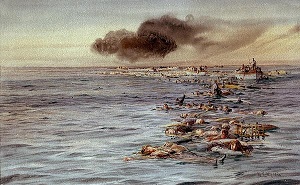 “Some women had on life preservers and others did not have any. After drifting some distance away from the ship, I turned and looked at it. About this time, there came a terrible explosion, and I saw the funnels falling. Soon the ship disappeared from view.
“Some women had on life preservers and others did not have any. After drifting some distance away from the ship, I turned and looked at it. About this time, there came a terrible explosion, and I saw the funnels falling. Soon the ship disappeared from view.
“As far as I could see, there were men, women, and children floating in the water. Some were dead and some were living. The women were screaming for help. Some men were badly mangled.
“I saw a young man with whom I had become well acquainted on the trip go floating by me. He looked up at me and exclaimed ‘God, help me, Tommy.’ His appeal went straight to my heart. I hope I shall never witness such a scene again.”
Laying of Wreaths
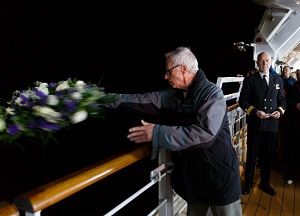 At 0330 hours on 7 May Cunard’s Queen Victoria will pause over the wreck site. Commodore Rynd and Cunard Director Angus Struthers will lay wreaths and passengers travelling who had relatives on Lusitania will offer their own floral tributes prior to Queen Victoria paying her own tribute by sounding her fog horn.
At 0330 hours on 7 May Cunard’s Queen Victoria will pause over the wreck site. Commodore Rynd and Cunard Director Angus Struthers will lay wreaths and passengers travelling who had relatives on Lusitania will offer their own floral tributes prior to Queen Victoria paying her own tribute by sounding her fog horn.
Casualty or Conspiracy?
On October 5, 1914, Alfred Booth - then Chairman of Cunard - was “required” to meet the Secretary to the Admiralty, Sir William Graham Greene, in the Smoking Room of the Reform Club in London's Pall Mall. There Booth was given instructions he did not want to hear: rather than being laid up, as Cunard wanted, and as Aquitania and Mauretania had been once their unsuitability as armed merchant cruisers became evident, Lusitania was to continue in commercial transatlantic service crewed by Cunard but under the direction of the Admiralty.
Indeed, the involvement of the Admiralty was comprehensive; not only was it to give the ship’s master the designated route for each crossing, but Cunard - including Booth himself - was forbidden to contact the master except with the permission of, or through, the Admiralty.
Booth could not demur; such powers for the Admiralty had been established in the agreement of 1903 which had led to the construction of Lusitania in the first place. As if that were not enough, the Admiralty took over the entire area of the ship forward of number two funnel for its own purposes, and the area was sealed off from the rest of the ship.
Carrying Contraband
It was soon evident that Lusitania was being used to carry “contraband,” mainly in the form of small armaments for use in the war in Europe, and it is doubtful if this was strictly legal in international law. However, the amounts were relatively small and were declared, after a fashion, on the manifests.
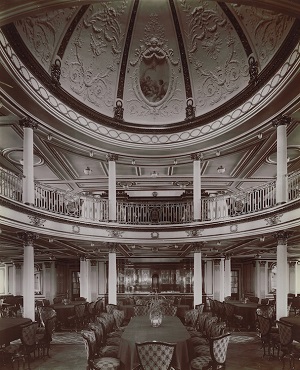 Common sense dictates that there was some official duplicity going on, although the extent of it is not clear. But the Admiralty was using Lusitania to carry cargo she should not have been carrying, and this could not have been done without the knowledge of officials in the United States - a neutral country at that stage, and one that wished to be seen to be so. But the war in Europe was also a lucrative business for America, and over $1,100,453, 950 worth of war related goods were bought from the U.S. in the space of one year.
Common sense dictates that there was some official duplicity going on, although the extent of it is not clear. But the Admiralty was using Lusitania to carry cargo she should not have been carrying, and this could not have been done without the knowledge of officials in the United States - a neutral country at that stage, and one that wished to be seen to be so. But the war in Europe was also a lucrative business for America, and over $1,100,453, 950 worth of war related goods were bought from the U.S. in the space of one year.
And so Lusitania continued her transatlantic duties under a senior Cunard master, Captain Daniel Dow. But on March 8, 1915 Captain Dow resigned from his position because, he said, he was no longer prepared to mix innocent passengers with armaments. He was, however, retained by Cunard; perhaps they felt he had a point. He was replaced as master of Lusitania by the notoriously grumpy and taciturn Captain William Turner, who made up for what he lacked in tact and diplomacy with an excellent and unblemished record as a seafarer.
Liable to Destruction
On the day Lusitania was due to make her 101st crossing, May 1, 1915, a notice appeared in New York newspapers and in other major cities signed by the Imperial German Embassy in Washington. It advised would be passengers that vessels flying the flag of Great Britain or of any of her allies “are liable to destruction,” and that travelers did so at their own risk. The intention was clear enough.
On the same day, Captain Turner made his way to see Sir Courtney Bennett, the British Consul General in New York, to receive his Admiralty instructions for the voyage he was about to undertake to Liverpool. There were none. He was told by Sir Courtney simply to follow his previous course and to rendezvous 10 miles south of the Fastnet Rock off the south west coast of Ireland with his escort, for the final leg of the voyage, the Royal Navy cruiser the Juno.
Turner took the ship down the Hudson and out into the open sea that afternoon. There was some nervousness on board, partly as a result of the German warning in that day’s papers - though few passengers had cancelled - and Turner shared with passengers the reassurance he himself felt that the ship was to be in the hands of the Royal Navy once it got to the area where U boats were reputed to be.
Until that point he knew he could rely on the ship’s speed as the best defense against attack. Lusitania had been built to travel at 25 knots, but with a coal consumption of 1,000 tons a day at that speed one boiler had been closed down to save fuel, but her top speed was still a healthy 21 knots. No ship travelling at over 14 knots had ever been torpedoed by U boats capable of only nine, and Turner took some comfort in that too.
U Boat Knowledge
Back at the Admiralty in London there was quite detailed knowledge of U boat positions and movements; this was based not just on regular reports of attacks that came in, but on the fortuitous and crucial fact that the Admiralty was in possession of all the German transmission codes. Every message that passed between German naval headquarters and its entire fleet of U boats was intercepted and decoded; the British were as aware of what U boats were up to as was Kaiser Wilhelm himself.
They put this to good use when, for example, the Cunard liners Ausonia and Transylvania (at the time under the command of Captain Turner) were ordered into Queenstown (now Cobh) in order to avoid the malign intentions of U 21 lurking just off the Irish Coast. But, for Lusitania in May 1914 no such beneficial use of valuable knowledge seems to have been made.
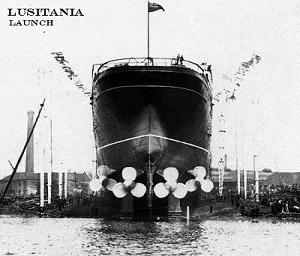 Indeed, in 1927, some 12 years after the event, a Commander Joseph Kenworthy - who at the time of the Lusitania sinking had been a member of Naval Intelligence - published a book. In it he refers to a meeting which took place on May 5, 1915, two days before Lusitania went down, at which were present the First Lord of the Admiralty, Winston Churchill, and Admiral Jackie Fisher, the First Sea Lord. In front of them was a large map on which were marked the positions of shipping off the South Coast of Ireland. There was the U20, just north west of Fastnet; and there was Lusitania; and there too was the Juno.
Indeed, in 1927, some 12 years after the event, a Commander Joseph Kenworthy - who at the time of the Lusitania sinking had been a member of Naval Intelligence - published a book. In it he refers to a meeting which took place on May 5, 1915, two days before Lusitania went down, at which were present the First Lord of the Admiralty, Winston Churchill, and Admiral Jackie Fisher, the First Sea Lord. In front of them was a large map on which were marked the positions of shipping off the South Coast of Ireland. There was the U20, just north west of Fastnet; and there was Lusitania; and there too was the Juno.
And in his reflections on the meeting in “The Freedom of the Seas,” Kenworthy had this to say: “The Lusitania was sent at considerably reduced speed into an area where a U boat was known to be waiting, and with her escort withdrawn.” Her escort withdrawn. No-one thought to tell Captain Turner that Juno, rather than acting as escort from Fastnet, had been ordered back to Queenstown.
And, also as the Admiralty knew, the U20 was not just sitting there doing nothing. On May 5 she torpedoed and sank a small coastal vessel Earl of Lathom; on May 6 she sent to the bottom two steamers Centurion and Candidate. And the Admiralty knew of all this activity by the U20 on the course Lusitania was to take the following day. Did they tell Captain Turner? They did not.
Seriously Disturbed
By breakfast time on May 7 the loss of these three vessels was common knowledge in Liverpool, and Albert Booth was seriously disturbed by them. Forbidden to contact Captain Turner himself, he immediately called Admiral Stileman, the senior naval officer in Liverpool, to do so urgently. Booth was satisfied that Lusitania, like Ausonia and Transylvania earlier, would be diverted to Queenstown. She was not.
Instead the Admiralty simply sent out a general warning to all shipping that U boats were active in the area. No more.
By now, on board Lusitania, Captain Turner realized that the naval escort he had relied on so much to ease the minds of anxious passengers was not there. He comforted himself with the thought that he may just have missed her in the fog.
At about the same time, back in London, the British Foreign Secretary Sir Edward Grey was meeting another Edward, Colonel Edward House, special adviser to US President Woodrow Wilson. “What would America do,” asked Grey, “if the Germans were to sink a passenger ship with Americans on board?”
Bringing the U.S. into the War
And House, according to his own memoirs, replied, “It would be sufficient to carry us into war.” Strangely, just a few hours later House met the King at Buckingham Palace; “And what,” asked the King, “would the Americans do if the Germans were to sink Lusitania?”
.jpg) There was clearly a train of thought among the British political establishment, an establishment that although fully aware of the danger into which Lusitania was sailing did absolutely nothing about it.
There was clearly a train of thought among the British political establishment, an establishment that although fully aware of the danger into which Lusitania was sailing did absolutely nothing about it.
At Fastnet, in the absence of Juno, Captain Turner might have expected a message directing him up the west coast of Ireland, away from submarine activity, to approach Liverpool from the north. No such instruction arrived, and without it Turner had no option but to proceed on the course he was taking.
In the meantime he followed standard instructions for ships in a zone of U boat activity to the letter: he swung out the lifeboats, closed watertight doors where possible for a ship under way, increased lookouts and ordered portholes to be closed. Many were not, but the order was issued nonetheless.
On the Day
Having sighted the Irish Coast, but being unsure of his exact position (there being no sophisticated positioning instruments on the bridge in those days) he ran parallel to the coast at about 11 miles distant to achieve an accurate bearing. And then, once he was sure of his position, he calculated that in order to time his arrival at the Mersey so that he did not have to wait for the tide to be right to enter, something which would have made the ship an easy target, he needed to reduce his speed to 18 knots. That would allow him a straight run into the Mersey without need to loiter in the dangerous waters outside, but still, he thought, gave him sufficient speed to thwart a U boat attack.
At 1410 hours Kapitanleutenant Walther Schweiger, commander of the German submarine U20, could plainly see and identify Lusitania through his periscope. He ordered one torpedo to be fired, which within seconds had struck Lusitania on the starboard side just aft of the bridge. He noted three important things in his log, and sent messages back to base relaying the same information - which the British received and decoded: he reported he had fired one torpedo, that after the explosion caused by that torpedo there was almost immediately a second, larger explosion, and that the ship sank in under twenty minutes.
Of 1,275 passengers on board, 785 died, of which 128 were neutral American citizens including the multimillionaire Alfred Vanderbilt. Of the 702 crew, 413 died; 94 of the 129 children on board died, as did 35 of the 39 babies. So did three unidentified stowaways. The world was outraged.
Celebration
But Germany was ecstatic, to the extent that Karl Gotz, a jeweler, designed and produced just 44 samples of a medal to celebrate the sinking of the ship. Unfortunately for Germany, one got into the hands of the British and Gordon Selfridge, of department store fame, paid for 300,000 of them to be produced and distributed. They sold at a shilling each, with the proceeds going to St Dunstan’s.
Very rapidly Germany’s demonstration of U boat supremacy was turning into a public relations catastrophe. The medals, incidentally, bore the wrong date of May 5 on both the German and British versions, and the British version has the additional error of spelling “May” in the English manner rather than the German.
Conspiracy Theories
Naturally, the circumstances surrounding the loss of Lusitania have generated an entire tribe of conspiracy theories. Some people believe the British Government, and notably Churchill, engineered the sinking of Lusitania to bring America into the war and his case is not helped by injudicious comments he made to the effect that the sinking of neutral shipping, and notably American flagged ships, was necessary to bring the non-aligned into the war on the side of the allies.
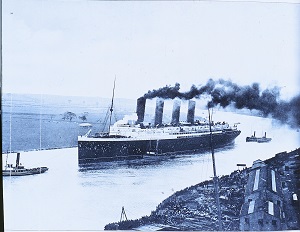
Yet others puzzle over the second explosion and ask was there a second torpedo, or did the first ignite contraband explosives, or did the boilers blow up or was coal dust ignited? Certainly such a large hole was blown into the starboard side that she listed immediately and sank in just 18 minutes - the list and the speed of sinking being the cause of many deaths.
And three other puzzles remain: why, even today, does the Admiralty warn against diving to the wreck and why are so many official files relating to Lusitania “missing”? And, perhaps most puzzling of all, why was the Admiralty so utterly determined to blame Captain Turner that it put immense pressure on Lord Mersey, who led the official enquiry, to find against Turner, that it failed to produce all the requisite documents at the enquiry, that it carefully selected witnesses who would give an agreed line, and that it wrote crew members’ witness statements for them?
Admiral Lord Fisher, the First Sea Lord at the time commented “I hope Captain Turner will be arrested immediately after the enquiry whatever the verdict or finding may be,” and “I am absolutely certain Captain Turner is a scoundrel and has been bribed.” Churchill weighed in with: “we shall pursue the Captain without check.”
The First Enquiry
The first enquiry into the sinking took place the day after at Kinsale, where many survivors and bodies had been landed, and was presided over by John Horgan, the local coroner. The chief witness was Captain Turner, still in a slightly damp uniform which had endured four hours in a cold sea only the day before. At the end of his evidence the coroner commented, “We express our appreciation of the courage you have shown which is worthy of the high traditions of the service to which you belong.” At this, Captain Turner burst into tears.
The verdict of the coroner was that Germany, and Germany alone, was guilty of wilful and wholesale murder. It was fortuitous that Horgan acted as expeditiously as he did, for no sooner had the verdict been given than word arrived from the Admiralty forbidding the holding of an inquest and demanding that Captain Turner should not appear in public. They were as late with that as with everything else concerning Lusitania.
The Full Enquiry
The full enquiry, under the chairmanship of an accomplished lawyer, Lord Mersey, who had also presided over the Titanic enquiry three years earlier, was held in London some months later. He sat with four expert assessors, one of whom, Admiral Sir Frederick Inglefield, represented the Admiralty. He was the Admiralty expert whose solution to the U boat threat was for ships crews to place bags over periscopes.
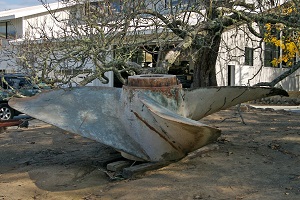 In the course of the enquiry Lord Mersey received a note from the Admiralty stating, “It is considered politically expedient that Captain Turner of the Lusitania be most prominently blamed for the disaster.” But Mersey was a fair man, and he was having none of that. He was even more upset by the behavior of the Admiralty when he discovered that they had knowingly withheld from the enquiry copies of messages which they had sent to the Lusitania, and denied sending others of which there was a clear record.
In the course of the enquiry Lord Mersey received a note from the Admiralty stating, “It is considered politically expedient that Captain Turner of the Lusitania be most prominently blamed for the disaster.” But Mersey was a fair man, and he was having none of that. He was even more upset by the behavior of the Admiralty when he discovered that they had knowingly withheld from the enquiry copies of messages which they had sent to the Lusitania, and denied sending others of which there was a clear record.
Lord Mersey and three of the assessors absolved Captain Turner of blame. Only Inglefield, from the Admiralty, dissented.
Mersey himself was so outraged by the manner in which the enquiry had been pressured that he wrote to the Prime Minister refusing to accept any fee, and stating he wished to be excused from presiding over any future such enquiries.
So, who was to blame?
Well, clearly the German submarine commander and the regime whose instructions he followed must bear blame for what the Kinsale coroner called wilful and wholesale murder. Had the torpedo not been fired, no-one would have died.
But were they justified in sinking an unarmed merchant ship in a time of war? The Germans argued that the ship was carrying contraband, and there is some evidence for this, but she was emphatically not armed and was not carrying troops.
Both the British and American governments must take some blame as it is clearly fact that Lusitania was carrying four million rounds of ammunition and unprimed shells of which both were aware. But it has also been established that the quantities were modest, and most certainly would not have resulted in the massive second explosion which was reported by Schweiger and many witnesses. It is far more likely that was caused by the torpedo striking the boiler room.
The Admiralty’s Motives
But was the sinking engineered by the Admiralty to draw America into the war? There is certainly superficially attractive evidence to suggest this, such as the fact that the Admiralty knew where the U20 was and what it was doing and yet no attempt appears to have been made to divert Lusitania, or the fact that Juno was withdrawn as an escort for whatever reason. The remarkably similar conversations Sir Edward Grey and the King had with Colonel House that very morning look suspicious, as does Churchill's recorded wish that neutral shipping should be attacked. Most suspiciously of all were the concerted and strenuous efforts to blame the entirely blameless Captain Turner.
But much of this, if not all of it, could equally well be explained by sheer incompetence rather than malice. Even the attacks on Turner have the stench of desperate attempts to blame “anybody but us.”
Was Turner to Blame?
So, then, was Captain Turner to blame? On that it is possible to say “most emphatically not.” What exactly was he accused of? Well, firstly of sailing into an area known to be frequented by U Boats - and yet he had no choice as he was forbidden to divert except by express authority, which he did not receive.
Secondly, he was accused of disobeying a general advice to mariners to keep away from land; but, having emerged from fog it was clearly necessary for him to take a bearing using landmarks - and even so he was 11 miles from land when the torpedo struck. It is interesting to note that just three months later White Star’s Arabic was torpedoed more than 50 miles from land, so the advice seems to have been little more than guesswork from the desk bound.
Zig Zagging
Thirdly he was criticized for not zig zaging in order to confuse the U boats but in fact he never received any instruction to do this, and as he himself pointed out at a later enquiry in the United States (which directed those making claims against Cunard to send them to the German Government) his command after Lusitania was Ivernia, which was torpedoed with Turner on the bridge while zig zaging.
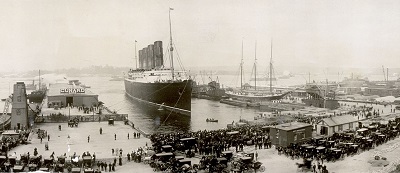 It is certainly true that there was much confusion on the ship as it sank, though Turner can hardly be blamed for that. In those days passengers were not allocated specific lifeboats (as crew were) and there was no tannoy system with which to transmit instructions. And, of course, the speed of the sinking and the ship’s list rendered lowering the lifeboats almost impossible. Many of those who died were victims of hypothermia or of placing their life jackets on the wrong way up - again hardly the fault of the man who stayed on the bridge till his ship sank beneath him, and then survived in an icy ocean for four hours.
It is certainly true that there was much confusion on the ship as it sank, though Turner can hardly be blamed for that. In those days passengers were not allocated specific lifeboats (as crew were) and there was no tannoy system with which to transmit instructions. And, of course, the speed of the sinking and the ship’s list rendered lowering the lifeboats almost impossible. Many of those who died were victims of hypothermia or of placing their life jackets on the wrong way up - again hardly the fault of the man who stayed on the bridge till his ship sank beneath him, and then survived in an icy ocean for four hours.
Cunard, that most conservative of companies which since its inception had walked hand in hand with governments and had striven to be at one with the establishment, knew Captain Turner was entirely innocent of the crimes of which the Admiralty wished him to be condemned. In a magnificent piece of understated thumbing of the corporate nose, they not only refused to sack him, as Admiral Fisher demanded, but in 1917, on the retirement of Commodore Barr, they elevated Captain Turner to Fleet Commodore. Such a subtle snub to the Admiralty bully boys must have given Alfred Booth quiet satisfaction. And it possibly even brought a smile to the lips of the maligned and taciturn Captain Turner.
Extract from ‘Cunard 175 – The Triumph of a Great Tradition’ by Eric Flounders and Michael Gallagher (Michael Gallagher is Cunard’s PR Manager and Historian)
The opinions expressed herein are the author's and not necessarily those of The Maritime Executive.
